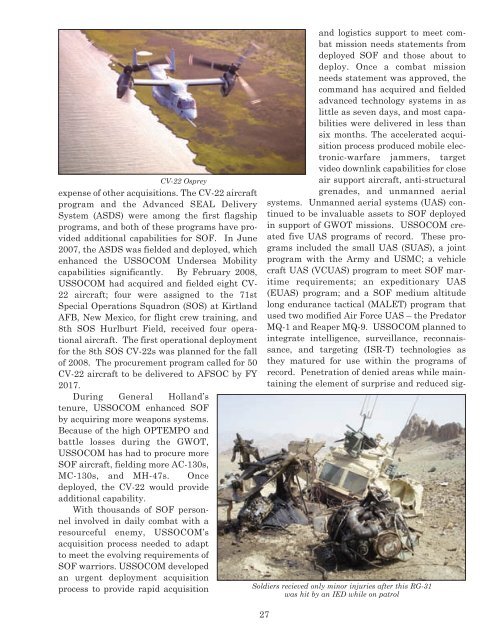HQ$History - United States Special Operations Command
HQ$History - United States Special Operations Command
HQ$History - United States Special Operations Command
Create successful ePaper yourself
Turn your PDF publications into a flip-book with our unique Google optimized e-Paper software.
CV-22 Osprey<br />
expense of other acquisitions. The CV-22 aircraft<br />
program and the Advanced SEAL Delivery<br />
System (ASDS) were among the first flagship<br />
programs, and both of these programs have provided<br />
additional capabilities for SOF. In June<br />
2007, the ASDS was fielded and deployed, which<br />
enhanced the USSOCOM Undersea Mobility<br />
capabilities significantly. By February 2008,<br />
USSOCOM had acquired and fielded eight CV-<br />
22 aircraft; four were assigned to the 71st<br />
<strong>Special</strong> <strong>Operations</strong> Squadron (SOS) at Kirtland<br />
AFB, New Mexico, for flight crew training, and<br />
8th SOS Hurlburt Field, received four operational<br />
aircraft. The first operational deployment<br />
for the 8th SOS CV-22s was planned for the fall<br />
of 2008. The procurement program called for 50<br />
CV-22 aircraft to be delivered to AFSOC by FY<br />
2017.<br />
During General Holland’s<br />
tenure, USSOCOM enhanced SOF<br />
by acquiring more weapons systems.<br />
Because of the high OPTEMPO and<br />
battle losses during the GWOT,<br />
USSOCOM has had to procure more<br />
SOF aircraft, fielding more AC-130s,<br />
MC-130s, and MH-47s. Once<br />
deployed, the CV-22 would provide<br />
additional capability.<br />
With thousands of SOF personnel<br />
involved in daily combat with a<br />
resourceful enemy, USSOCOM’s<br />
acquisition process needed to adapt<br />
to meet the evolving requirements of<br />
SOF warriors. USSOCOM developed<br />
an urgent deployment acquisition<br />
process to provide rapid acquisition<br />
and logistics support to meet combat<br />
mission needs statements from<br />
deployed SOF and those about to<br />
deploy. Once a combat mission<br />
needs statement was approved, the<br />
command has acquired and fielded<br />
advanced technology systems in as<br />
little as seven days, and most capabilities<br />
were delivered in less than<br />
six months. The accelerated acquisition<br />
process produced mobile electronic-warfare<br />
jammers, target<br />
video downlink capabilities for close<br />
air support aircraft, anti-structural<br />
grenades, and unmanned aerial<br />
systems. Unmanned aerial systems (UAS) continued<br />
to be invaluable assets to SOF deployed<br />
in support of GWOT missions. USSOCOM created<br />
five UAS programs of record. These programs<br />
included the small UAS (SUAS), a joint<br />
program with the Army and USMC; a vehicle<br />
craft UAS (VCUAS) program to meet SOF maritime<br />
requirements; an expeditionary UAS<br />
(EUAS) program; and a SOF medium altitude<br />
long endurance tactical (MALET) program that<br />
used two modified Air Force UAS – the Predator<br />
MQ-1 and Reaper MQ-9. USSOCOM planned to<br />
integrate intelligence, surveillance, reconnaissance,<br />
and targeting (ISR-T) technologies as<br />
they matured for use within the programs of<br />
record. Penetration of denied areas while maintaining<br />
the element of surprise and reduced sig-<br />
Soldiers recieved only minor injuries after this RG-31<br />
was hit by an IED while on patrol<br />
27

















